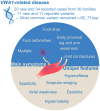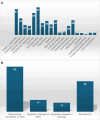Autosomal recessive VWA1-related disorder: comprehensive analysis of phenotypic variability and genetic mutations
- PMID: 39502942
- PMCID: PMC11535570
- DOI: 10.1093/braincomms/fcae377
Autosomal recessive VWA1-related disorder: comprehensive analysis of phenotypic variability and genetic mutations
Abstract
A newly identified subtype of hereditary axonal motor neuropathy, characterized by early proximal limb involvement, has been discovered in a cohort of 34 individuals with biallelic variants in von Willebrand factor A domain-containing 1 (VWA1). This study further delineates the disease characteristics in a cohort of 20 individuals diagnosed through genome or exome sequencing, incorporating neurophysiological, laboratory and imaging data, along with data from previously reported cases across three different studies. Newly reported clinical features include hypermobility/hyperlaxity, axial weakness, dysmorphic signs, asymmetric presentation, dystonic features and, notably, upper motor neuron signs. Foot drop, foot deformities and distal leg weakness followed by early proximal leg weakness are confirmed to be initial manifestations. Additionally, this study identified 11 novel VWA1 variants, reaffirming the 10 bp insertion-induced p.Gly25ArgfsTer74 as the most prevalent disease-causing allele, with a carrier frequency of ∼1 in 441 in the UK and Western European population. Importantly, VWA1-related pathology may mimic various neuromuscular conditions, advocating for its inclusion in diverse gene panels spanning hereditary neuropathies to muscular dystrophies. The study highlights the potential of lower quality control filters in exome analysis to enhance diagnostic yield of VWA1 disease that may account for up to 1% of unexplained hereditary neuropathies.
Keywords: VWA1; neuromuscular disorders; neuromyopathy; recessive disorders.
© The Author(s) 2024. Published by Oxford University Press on behalf of the Guarantors of Brain.
Conflict of interest statement
The authors report no competing interests.
Figures





References
-
- Deschauer M, Hengel H, Rupprich K, et al. Bi-allelic truncating mutations in VWA1 cause neuromyopathy. Brain. 2021;144(2):574–583. - PubMed
Associated data
Grants and funding
LinkOut - more resources
Full Text Sources
